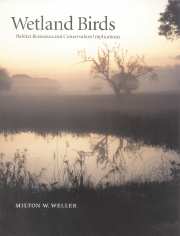Book contents
- Frontmatter
- Contents
- List of plates
- Preface
- Acknowledgments
- 1 Introduction
- 2 Wetlands: what, where, and why
- 3 Major groups of birds that use wetlands
- 4 Water and other resource influences
- 5 Foods, feeding tactics, strategies, and guilds
- 6 Bird mobility and wetland predictability
- 7 Other behavioral and physical influences on wetland living
- 8 Spatial and structural patterns
- 9 Habitat dynamics: water, plant succession, and time
- 10 Population consequences of wetland abundance and quality
- 11 How birds influence wetlands
- 12 Conservation implications
- 13 Measures of bird habitat use and quality
- 14 Current status and some conservation problems
- 15 Conservation and management strategies
- 16 Outlook
- 17 Epilogue
- Appendix 1 Scientific names of birds and bird groups
- Appendix 2 Scientific names of animals and animal groups other than birds
- Appendix 3 Scientific names of plants and plant groups
- Index of birds and bird groups
- Subject index
2 - Wetlands: what, where, and why
Published online by Cambridge University Press: 02 October 2009
- Frontmatter
- Contents
- List of plates
- Preface
- Acknowledgments
- 1 Introduction
- 2 Wetlands: what, where, and why
- 3 Major groups of birds that use wetlands
- 4 Water and other resource influences
- 5 Foods, feeding tactics, strategies, and guilds
- 6 Bird mobility and wetland predictability
- 7 Other behavioral and physical influences on wetland living
- 8 Spatial and structural patterns
- 9 Habitat dynamics: water, plant succession, and time
- 10 Population consequences of wetland abundance and quality
- 11 How birds influence wetlands
- 12 Conservation implications
- 13 Measures of bird habitat use and quality
- 14 Current status and some conservation problems
- 15 Conservation and management strategies
- 16 Outlook
- 17 Epilogue
- Appendix 1 Scientific names of birds and bird groups
- Appendix 2 Scientific names of animals and animal groups other than birds
- Appendix 3 Scientific names of plants and plant groups
- Index of birds and bird groups
- Subject index
Summary
An explanation of avian habitat use and distribution in wetlands involves understanding what wetlands are, identifying the geological setting (geomorphology), water sources (hydrology), and climatic influences of the site that explain why and where these unique biotic communities occur. In addition, any explanation must describe the characteristic biological and structural diversity that birds may perceive. To facilitate discussion and identification of essential features of various wetland types, I must review some current wetland classification systems used in mapping and regulatory decisions because this is the context in which many readers deal, but I shall select those especially useful in descriptions of bird habitats. For legal purposes, it is often necessary to identify the boundary between a wetland and the adjoining upland or the open water of more aquatic habitats, but this discussion will focus on features that birds seem to perceive and on boundaries that appear to influence them.
Classification of wetlands
Wetlands are not easily defined because they range from near-terrestrial to the aquatic, and because many are dynamic in water regime and, therefore, variable in vegetation patterns and bird use. Some vary rather predictably and dramatically by season or year, and many also are subject to long-term variation owing to large-scale climate patterns and cycles. Therefore, wetlands are sometimes not recognizable by standing water, and their vegetation can be equally deceiving. In addition to the presence of shallow water or wet soil periodically, two other key features of wetlands are the periodic presence of water-adapted plants (hydrophytes), which range from mosses to giant trees, and hydric soil, with biochemical features influenced by anaerobic conditions of flooding (Cowardin et al. 1979).
- Type
- Chapter
- Information
- Wetland BirdsHabitat Resources and Conservation Implications, pp. 13 - 22Publisher: Cambridge University PressPrint publication year: 1999



